The Chronic Phase Markers Market is estimated to be valued at USD 4.1 billion in 2025 and is projected to reach USD 8.6 billion by 2035, registering a compound annual growth rate (CAGR) of 7.8% over the forecast period.
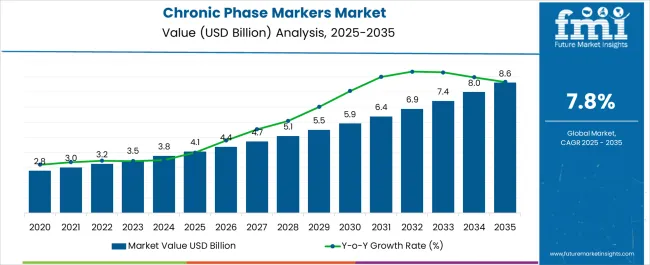
| Metric | Value |
|---|---|
| Chronic Phase Markers Market Estimated Value in (2025 E) | USD 4.1 billion |
| Chronic Phase Markers Market Forecast Value in (2035 F) | USD 8.6 billion |
| Forecast CAGR (2025 to 2035) | 7.8% |
The Chronic Phase Markers market is experiencing steady growth, supported by rising incidences of chronic diseases, increasing cancer prevalence, and growing demand for advanced diagnostic tools. Chronic phase markers are being widely adopted for their ability to assist in early detection, disease progression monitoring, and treatment evaluation, which are critical in improving patient outcomes. The market is benefiting from technological advancements such as biomarker-based assays, high-throughput testing methods, and integration with automated laboratory systems, which enhance accuracy and efficiency.
Increased awareness regarding personalized medicine and the importance of timely diagnosis is further accelerating adoption. Investments in healthcare infrastructure, clinical research, and precision diagnostics are reinforcing market expansion, especially in regions with rising healthcare expenditures. Additionally, growing collaborations between research institutions and biopharmaceutical companies are facilitating the discovery of novel biomarkers, expanding the scope of applications.
Regulatory frameworks focusing on patient safety and diagnostic reliability are driving hospitals and laboratories to integrate chronic phase markers into routine clinical practice As demand for reliable and cost-effective diagnostic solutions increases globally, the market is positioned for sustained long-term growth.
The chronic phase markers market is segmented by product type, end user, and geographic regions. By product type, chronic phase markers market is divided into Tumor Markers – Tumor Markers, Rheumatoid-Inflammatory Disease Marker – Anti – DNAase B, Cardiac Markers – Creatine Kinase, Thrombophilia Markers – Antithrombin, and Thyroid Markers – Thyroid Stimulating Hormone. In terms of end user, chronic phase markers market is classified into Hospitals And Clinics, Research And Academic Institutions, and Diagnostic Labs And Centers. Regionally, the chronic phase markers industry is classified into North America, Latin America, Western Europe, Eastern Europe, Balkan & Baltic Countries, Russia & Belarus, Central Asia, East Asia, South Asia & Pacific, and the Middle East & Africa.
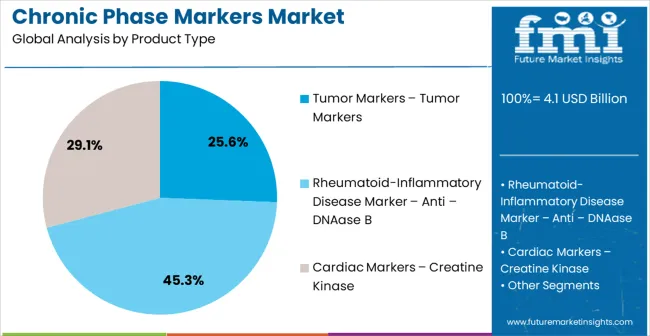
The tumor markers segment is projected to account for 25.6% of the Chronic Phase Markers market revenue in 2025, positioning it as one of the leading product types. This growth is being driven by the crucial role tumor markers play in cancer detection, treatment monitoring, and prognosis assessment. The segment is supported by the rising prevalence of cancers globally and the need for non-invasive, accurate, and cost-effective diagnostic tools.
Tumor markers enable clinicians to track disease progression, evaluate treatment effectiveness, and detect recurrences, providing significant value in patient care. Technological improvements in immunoassays and molecular testing have improved sensitivity and specificity, enhancing the clinical utility of tumor markers. Their integration into personalized medicine approaches is further fueling demand, as treatment regimens increasingly rely on biomarker-based evidence.
Growing awareness campaigns on cancer screening and advancements in companion diagnostics are also strengthening market adoption As research continues to identify novel tumor-specific markers, this segment is expected to retain strong momentum, contributing significantly to the growth of the overall market.
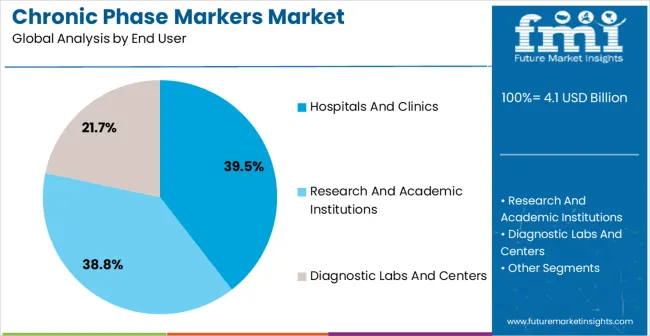
The hospitals and clinics segment is expected to hold 39.5% of the market revenue in 2025, making it the largest end user of chronic phase markers. Growth in this segment is being supported by the increasing reliance on clinical settings for advanced diagnostics, particularly in the management of chronic and complex diseases such as cancer. Hospitals and clinics are well-equipped with advanced laboratory infrastructure, skilled personnel, and integrated healthcare systems, enabling efficient utilization of biomarker-based testing.
The rising volume of diagnostic procedures performed in hospitals, coupled with the growing emphasis on patient-centric care, has further boosted adoption. In addition, hospitals and clinics serve as referral centers for specialized diagnostics, making them primary users of chronic phase markers. Government funding, insurance coverage, and healthcare reforms that support early detection and disease management are strengthening demand within this segment.
Furthermore, the growing adoption of digital health platforms and automation in hospital laboratories is enhancing test accuracy and efficiency As healthcare systems continue to prioritize timely and precise diagnostics, hospitals and clinics are expected to remain the largest revenue contributors in the market.
Markers are broadly categorized as biomarkers or molecular markers and biochemical markers. Biomarker, also known as biological marker is commonly used to carry out detection of living organism which acts as a causative agent for specific diseases.
It usually refers to a measurable indicator for various biological states or disease conditions in the human body. Biomarker is any substance that can be utilized as an indicator of specific disease condition and is often evaluated to detect pathogenic processes, normal biological process, or pharmacologic response to medical treatment.
The elevated levels or absence of these biological markers may indicate the onset or late stage of a chronic disease such as cancer. However, chronic phase indicates early stages of chronic leukemia which is a type of cancer in white blood cells. It constitutes high amounts of abnormal white blood cells in bone marrow and blood.
Chronic phase markers are the biomarkers that help in detection of a disease condition with the presence of their elevated levels in patient’s body. Chronic phase markers have vast application in disease diagnosis, treatment, as well as study of disease condition and its stage which increases the demand in chronic phase markers market.
These markers are majorly intended for detection of chronic diseases including tumours, rheumatoid inflammatory disease, thyroid cancer, chronic cardiac disorders and others. In a chronic phase, patients commonly have less than 10 percent blast cells present in the blood stream or bone marrow samples obtained from the affected individuals.
Chronic phase markers are capable of extreme performance and do not allow confusion between acute and chronic phase detection. Many of these biomarkers work well as both acute and chronic phase markers and thus contribute majorly to the revenue generation in chronic phase markers market. These chronic phase markers are broadly used to diagnose cancerous conditions and thus generates large revenues in the chronic phase markers market owing to their increased demand in health-care centers.
Chronic phase markers market on the basis of product type is classified into tumor markers, cardiac markers, inflammatory disease markers, thyroid markers and others. However, the main customer base for chronic phase markers include hospitals and clinics, research and academic institutions, and diagnostic labs and centers.
On the other hand, chronic phase markers market is gaining profit due to rising incidence of chronic diseases across the globe. Chronic myelogenous leukemia is one of the deadly chronic phase disease which registers 8,950 new cases in United States in 2025.
Recently, new prognostic markers have been developed that enables improved diagnostics to detect chronic phase in less time. Such biological innovations tend to propel the growth of chronic phase markers market across the globe.
Chronic phase markers consist of various proteins and enzymes used for specific detection of human disease conditions and registers a significant revenue growth in the chronic phase markers market. These biomarkers are used for a variety of diseases including multiple types of cancer, diabetes, malaria, and others, and offers an affordable disease detection platform.
This is further anticipated to drive the demand for chronic phase markers and thereby increasing revenue generation in chronic phase markers market.
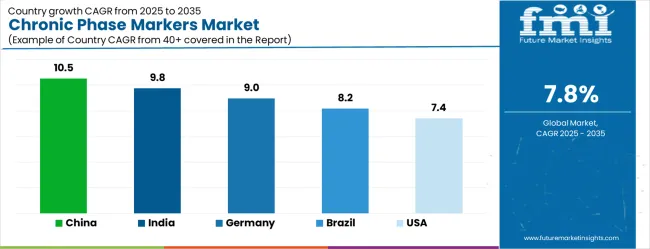
| Country | CAGR |
|---|---|
| China | 10.5% |
| India | 9.8% |
| Germany | 9.0% |
| Brazil | 8.2% |
| USA | 7.4% |
| UK | 6.6% |
| Japan | 5.9% |
The Chronic Phase Markers Market is expected to register a CAGR of 7.8% during the forecast period, exhibiting varied country level momentum. China leads with the highest CAGR of 10.5%, followed by India at 9.8%. Developed markets such as Germany, France, and the UK continue to expand steadily, while the USA is likely to grow at consistent rates. Japan posts the lowest CAGR at 5.9%, yet still underscores a broadly positive trajectory for the global Chronic Phase Markers Market. In 2024, Germany held a dominant revenue in the Western Europe market and is expected to grow with a CAGR of 9.0%. The USA Chronic Phase Markers Market is estimated to be valued at USD 1.5 billion in 2025 and is anticipated to reach a valuation of USD 1.5 billion by 2035. Sales are projected to rise at a CAGR of 0.0% over the forecast period between 2025 and 2035. While Japan and South Korea markets are estimated to be valued at USD 208.1 million and USD 136.4 million respectively in 2025.
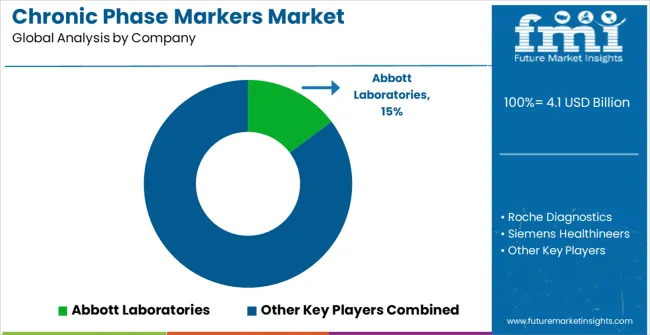
| Item | Value |
|---|---|
| Quantitative Units | USD 4.1 Billion |
| Product Type | Tumor Markers – Tumor Markers, Rheumatoid-Inflammatory Disease Marker – Anti – DNAase B, Cardiac Markers – Creatine Kinase, Thrombophilia Markers – Antithrombin, and Thyroid Markers – Thyroid Stimulating Hormone |
| End User | Hospitals And Clinics, Research And Academic Institutions, and Diagnostic Labs And Centers |
| Regions Covered | North America, Europe, Asia-Pacific, Latin America, Middle East & Africa |
| Country Covered | United States, Canada, Germany, France, United Kingdom, China, Japan, India, Brazil, South Africa |
| Key Companies Profiled | Abbott Laboratories, Roche Diagnostics, Siemens Healthineers, Thermo Fisher Scientific, Bio-Rad Laboratories, Danaher Corporation, Qiagen N.V., PerkinElmer Inc., Agilent Technologies, Illumina Inc., Becton, Dickinson and Company, Merck KGaA, and Sysmex Corporation |
The global chronic phase markers market is estimated to be valued at USD 4.1 billion in 2025.
The market size for the chronic phase markers market is projected to reach USD 8.6 billion by 2035.
The chronic phase markers market is expected to grow at a 7.8% CAGR between 2025 and 2035.
The key product types in chronic phase markers market are tumor markers – tumor markers, _cancer antigen, _cytokeratins, _serotonin, _thymidine kinase, _cancer associated serum antigen, _others, rheumatoid-inflammatory disease marker – anti – dnaase b, _anti – streptococcal hyaluronidase, _anti – streptokinase, _others, cardiac markers – creatine kinase, _myoglobin, _troponin, _others, thrombophilia markers – antithrombin, _homocysteine, thyroid markers – thyroid stimulating hormone, _thyroglobulin, _thyroxine and _others.
In terms of end user, hospitals and clinics segment to command 39.5% share in the chronic phase markers market in 2025.






Our Research Products

The "Full Research Suite" delivers actionable market intel, deep dives on markets or technologies, so clients act faster, cut risk, and unlock growth.

The Leaderboard benchmarks and ranks top vendors, classifying them as Established Leaders, Leading Challengers, or Disruptors & Challengers.

Locates where complements amplify value and substitutes erode it, forecasting net impact by horizon

We deliver granular, decision-grade intel: market sizing, 5-year forecasts, pricing, adoption, usage, revenue, and operational KPIs—plus competitor tracking, regulation, and value chains—across 60 countries broadly.

Spot the shifts before they hit your P&L. We track inflection points, adoption curves, pricing moves, and ecosystem plays to show where demand is heading, why it is changing, and what to do next across high-growth markets and disruptive tech

Real-time reads of user behavior. We track shifting priorities, perceptions of today’s and next-gen services, and provider experience, then pace how fast tech moves from trial to adoption, blending buyer, consumer, and channel inputs with social signals (#WhySwitch, #UX).

Partner with our analyst team to build a custom report designed around your business priorities. From analysing market trends to assessing competitors or crafting bespoke datasets, we tailor insights to your needs.
Supplier Intelligence
Discovery & Profiling
Capacity & Footprint
Performance & Risk
Compliance & Governance
Commercial Readiness
Who Supplies Whom
Scorecards & Shortlists
Playbooks & Docs
Category Intelligence
Definition & Scope
Demand & Use Cases
Cost Drivers
Market Structure
Supply Chain Map
Trade & Policy
Operating Norms
Deliverables
Buyer Intelligence
Account Basics
Spend & Scope
Procurement Model
Vendor Requirements
Terms & Policies
Entry Strategy
Pain Points & Triggers
Outputs
Pricing Analysis
Benchmarks
Trends
Should-Cost
Indexation
Landed Cost
Commercial Terms
Deliverables
Brand Analysis
Positioning & Value Prop
Share & Presence
Customer Evidence
Go-to-Market
Digital & Reputation
Compliance & Trust
KPIs & Gaps
Outputs
Full Research Suite comprises of:
Market outlook & trends analysis
Interviews & case studies
Strategic recommendations
Vendor profiles & capabilities analysis
5-year forecasts
8 regions and 60+ country-level data splits
Market segment data splits
12 months of continuous data updates
DELIVERED AS:
PDF EXCEL ONLINE
Chronic Sarcoidosis Therapeutics Market Size and Share Forecast Outlook 2025 to 2035
Chronic Venous Occlusions Treatment Market Size and Share Forecast Outlook 2025 to 2035
Phase Shifting Transformer Market Size and Share Forecast Outlook 2025 to 2035
Chronic Lymphocytic Leukemia Therapeutics Market Size and Share Forecast Outlook 2025 to 2035
Chronic Lymphocytic Leukemia Market Size and Share Forecast Outlook 2025 to 2035
Chronic Dryness Repair Market Analysis - Size and Share Forecast Outlook 2025 to 2035
Chronic Skin Redness Care Market Size and Share Forecast Outlook 2025 to 2035
Chronic immune thrombocytopenia treatment Market Size and Share Forecast Outlook 2025 to 2035
Chronic Hepatitis B Virus Testing Market Size and Share Forecast Outlook 2025 to 2035
The Chronic Wound Care Market is segmented by product, wound type and distribution channel from 2025 to 2035
Chronic Disease Management Market Size and Share Forecast Outlook 2025 to 2035
Chronic Brain Damage Treatment: Trends, Growth, and Key Developments
Chronic Pulmonary Hypertension Treatment Market Analysis and Forecast by Drug Type, Route of Administration, Distribution Channel, Region through 2035
Chronic Refractory Cough Treatment Market – Growth & Innovations 2025 to 2035
Chronic Granulomatous Disease (CGD) Management Market – Size, Share & Trends 2025 to 2035
Chronic Smell and Flavor Loss Treatment Market – Innovations & Growth 2025 to 2035
Chronic Pain Market Analysis – Growth, Demand & Forecast 2024 to 2034
Chronic Obstructive Pulmonary Disease (COPD) Market Trends – Growth & Forecast 2023-2033
Chronic Respiratory Diseases Treatment Market
Dual-Phase Cleanser Market Size and Share Forecast Outlook 2025 to 2035

Thank you!
You will receive an email from our Business Development Manager. Please be sure to check your SPAM/JUNK folder too.
Chat With
MaRIA